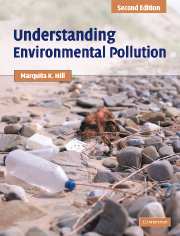Book contents
- Frontmatter
- Contents
- Preface
- Acknowledgements
- List of abbreviations and acronyms
- Chapter 1 Understanding pollution
- Chapter 2 Reducing pollution
- Chapter 3 Chemical toxicity
- Chapter 4 Chemical exposures and risk assessment
- Chapter 5 Air pollution
- Chapter 6 Acidic deposition
- Chapter 7 Global climate change
- Chapter 8 Stratospheric-ozone depletion
- Chapter 9 Water pollution
- Chapter 10 Drinking-water pollution
- Chapter 11 Solid waste
- Chapter 12 Hazardous waste
- Chapter 13 Energy
- Chapter 14 Persistent, bioaccumulative, and toxic
- Chapter 15 Metals
- Chapter 16 Pesticides
- Chapter 17 Pollution at home
- Chapter 18 Zero waste, zero emissions
- Index
- References
Chapter 4 - Chemical exposures and risk assessment
- Frontmatter
- Contents
- Preface
- Acknowledgements
- List of abbreviations and acronyms
- Chapter 1 Understanding pollution
- Chapter 2 Reducing pollution
- Chapter 3 Chemical toxicity
- Chapter 4 Chemical exposures and risk assessment
- Chapter 5 Air pollution
- Chapter 6 Acidic deposition
- Chapter 7 Global climate change
- Chapter 8 Stratospheric-ozone depletion
- Chapter 9 Water pollution
- Chapter 10 Drinking-water pollution
- Chapter 11 Solid waste
- Chapter 12 Hazardous waste
- Chapter 13 Energy
- Chapter 14 Persistent, bioaccumulative, and toxic
- Chapter 15 Metals
- Chapter 16 Pesticides
- Chapter 17 Pollution at home
- Chapter 18 Zero waste, zero emissions
- Index
- References
Summary
“We have inadvertently acquired a great deal of influence over the future habitability of the planet. At issue is whether we can assume the responsibility to go with it.”
Lester R. Brown, Worldwatch InstituteHow much ozone should we allow in the air we breathe? How much arsenic in drinking water? What level of dioxin in soil or food? These and similar questions arise every day. And, because we seldom have the luxury of answering “zero,” we must determine what level above zero is safe or essentially safe. The still-imperfect tool of chemical risk assessment assists us in this effort. To undertake a chemical risk assessment, we must first learn about our exposure to the chemical, a topic probed in Section I. Then Section II reviews epidemiological studies, investigations designed to detect relationships between human exposure to a chemical and adverse health effects. Section III introduces the four steps of chemical risk assessment. In Section IV we see what risk managers do with this information, how they explore ways to reduce or eliminate a chemical's risk. We also briefly examine exposures in impoverished countries.
SECTION I
Keep in mind the distinction between hazard and risk. You need to care about a hazardous chemical only if it becomes a risk. It only becomes a risk if you are exposed to it.
- Type
- Chapter
- Information
- Understanding Environmental PollutionA Primer, pp. 81 - 106Publisher: Cambridge University PressPrint publication year: 2004

